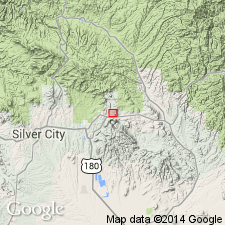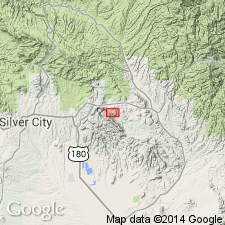
- Usage in publication:
-
- Hanover diorite porphyry
- Modifications:
-
- Incidental mention
- Dominant lithology:
-
- Porphyry
- AAPG geologic province:
-
- Basin-and-Range province
Summary:
Pg. 780, 782, 784. Hanover diorite porphyry. Incidental mention as diorite porphyry sill. Sills, sheets, and laccoliths of quartz diorite porphyry intruded Colorado shale but are truncated by prominent widespread angular unconformity probably representing early Tertiary (Eocene?) erosion. [Age is Late Cretaceous or younger.]
Sill in Pewabic Mine area, in Central mining district near Hanover, Grant Co., southwestern NM. Stock [approx. 1 mi northwest of Santa Rita in southeast corner of Sante Rita quadrangle].
Source: US geologic names lexicon (USGS Bull. 1200, p. 1665).

- Usage in publication:
-
- Hanover granodiorite porphyry
- Modifications:
-
- Overview
- Dominant lithology:
-
- Porphyry
- AAPG geologic province:
-
- Basin-and-Range province
Summary:
Pg. 287-288, fig. 3. Hanover granodiorite porphyry. (Also called Hanover intrusive.) Is body (stock) of relatively unaltered rock in region of intense mineralization. Generally coarsely crystalline showing prominent phenocrysts of plagioclase, hornblende, and biotite, ranging from porphyritic to granular. Ground mass dense and gray to buff. Accessory minerals include sphene, apatite, and zircon. Probably equivalent to Santa Rita granodiorite porphyry; Santa Rita characterized by prominence of biotite. [Age is Late Cretaceous or younger.]
Source: US geologic names lexicon (USGS Bull. 1200, p. 1665); supplemental information from GNU records (USGS DDS-6; Denver GNULEX).
For more information, please contact Nancy Stamm, Geologic Names Committee Secretary.
Asterisk (*) indicates published by U.S. Geological Survey authors.
"No current usage" (†) implies that a name has been abandoned or has fallen into disuse. Former usage and, if known, replacement name given in parentheses ( ).
Slash (/) indicates name conflicts with nomenclatural guidelines (CSN, 1933; ACSN, 1961, 1970; NACSN, 1983, 2005, 2021). May be explained within brackets ([ ]).

